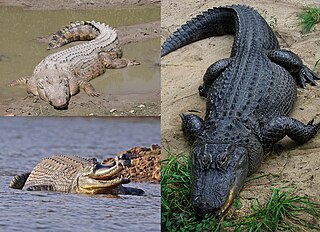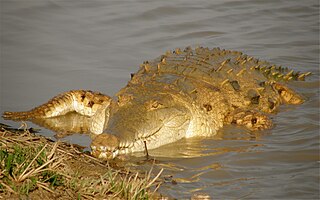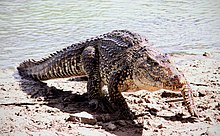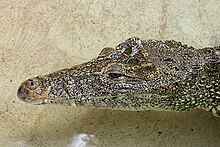
Crocodiles or true crocodiles are large semiaquatic reptiles that live throughout the tropics in Africa, Asia, the Americas and Australia. The term crocodile is sometimes used even more loosely to include all extant members of the order Crocodilia, which includes the alligators and caimans, the gharial and false gharial among other extinct taxa.

Crocodilia is an order of mostly large, predatory, semiaquatic reptiles known as crocodilians. They first appeared 94 million years ago in the Late Cretaceous period and are the closest living relatives of birds, as the two groups are the only known survivors of the Archosauria. Members of the order's total group, the clade Pseudosuchia, appeared about 250 million years ago in the Early Triassic period, and diversified during the Mesozoic era. The order Crocodilia includes the true crocodiles, the alligators and caimans, and the gharial and false gharial. Although the term crocodiles is sometimes used to refer to all of these, crocodilians is a less ambiguous vernacular term for members of this group.

Crocodylinae is a subfamily of true crocodiles within the family Crocodylidae, and is the sister taxon to Osteolaeminae.

An alligator, or colloquially gator, is a large reptile in the genus Alligator of the family Alligatoridae of the order Crocodilia. The two extant species are the American alligator and the Chinese alligator. Additionally, several extinct species of alligator are known from fossil remains. Alligators first appeared during the late Eocene epoch about 37 million years ago.

The saltwater crocodile is a crocodilian native to saltwater habitats, brackish wetlands and freshwater rivers from India's east coast across Southeast Asia and the Sundaic region to northern Australia and Micronesia. It has been listed as Least Concern on the IUCN Red List since 1996. It was hunted for its skin throughout its range up to the 1970s, and is threatened by illegal killing and habitat loss. It is regarded as dangerous to humans.

The Nile crocodile is a large crocodilian native to freshwater habitats in Africa, where it is present in 26 countries. It is widely distributed in sub-Saharan Africa, occurring mostly in the eastern, southern, and central regions of the continent, and lives in different types of aquatic environments such as lakes, rivers, swamps, and marshlands. Although capable of living in saline environments, this species is rarely found in saltwater, but occasionally inhabits deltas and brackish lakes. The range of this species once stretched northward throughout the Nile River, as far north as the Nile Delta. Lake Rudolf in Kenya has one of the largest undisturbed populations of Nile crocodiles.Generally, the adult male Nile crocodile is between 3.5 and 5 m in length and weighs 225 to 750 kg. However, specimens exceeding 6.1 m (20 ft) in length and 1,000 kg (2,200 lb) in weight have been recorded. It is the largest freshwater predator in Africa, and may be considered the second-largest extant reptile in the world, after the saltwater crocodile. Size is sexually dimorphic, with females usually about 30% smaller than males. The crocodile has thick, scaly, heavily armoured skin.

The American crocodile is a species of crocodilian found in the Neotropics. It is the most widespread of the four extant species of crocodiles from the Americas, with populations present from South Florida, the Caribbean islands of Cuba, Jamaica, Hispaniola, and the coasts of Mexico to as far south as Peru, Ecuador, Colombia, and Venezuela.

The freshwater crocodile, also known as the Australian freshwater crocodile, Johnstone's crocodile or the freshie, is a species of crocodile endemic to the northern regions of Australia. Unlike their much larger Australian relative, the saltwater crocodile, freshwater crocodiles are not known as man-eaters, although they bite in self-defence, and brief, nonfatal attacks have occurred, apparently the result of mistaken identity.

The Siamese crocodile is a medium-sized freshwater crocodile native to Indonesia, Brunei, East Malaysia, Laos, Cambodia, Myanmar, Thailand and Vietnam. The species is critically endangered and already extirpated from many regions. Its other common names include Siamese freshwater crocodile, Singapore small-grain, and soft-belly.

The Orinoco crocodile is a critically endangered crocodile. Its population is very small, and they can only be found in the Orinoco river basin in Venezuela and Colombia. Extensively hunted for their skins in the 19th and 20th centuries, it is one of the most endangered species of crocodiles. It is a very large species of crocodilian; males have been reported up to 6.8 m in the past, weighing over 900 kg (2,000 lb), but such sizes do not exist today, 5.2 m being a more widely accepted maximum size. A large male today may attain 4.2 m in length and can weigh up to 450 kg (1,000 lb), while females are substantially smaller with the largest likely to weigh around 225 kg (496 lb). Sexual dimorphism is not as profound as in other crocodilian species. The coloration is light even in adults.

The Philippine crocodile, also known as the Mindoro crocodile, the Philippine freshwater crocodile, the bukarot in Ilocano, and more generally as a buwaya in most Filipino lowland cultures, is one of two species of crocodiles found in the Philippines; the other is the larger saltwater crocodile (Crocodylus porosus). The Philippine crocodile, the species endemic only to the country, went from data deficient to critically endangered in 2008 from exploitation and unsustainable fishing methods, such as dynamite fishing. Conservation methods are being taken by the Dutch/Filipino Mabuwaya foundation, the Crocodile Conservation Society and the Zoological Institute of HerpaWorld in Mindoro island. It is strictly prohibited to kill a crocodile in the country, and it is punishable by law.

The New Guinea crocodile is a small species of crocodile found on the island of New Guinea north of the mountain ridge that runs along the centre of the island. The population found south of the mountain ridge, formerly considered a genetically distinct population, is now considered a distinct species, Hall's New Guinea crocodile. In the past it included the Philippine crocodile, C. n. mindorensis, as a subspecies, but today they are regarded as separate species. The habitat of the New Guinea crocodile is mostly freshwater swamps and lakes. It is most active at night when it feeds on fish and a range of other small animals. A female crocodile lays a clutch of eggs in a nest composed of vegetation and she lies up nearby to guard the nest. There is some degree of parental care for newly hatched juveniles. This crocodile was over-hunted for its valuable skin in the mid 20th century, but conservation measures have since been put in place, it is reared in ranches and the International Union for Conservation of Nature (IUCN) lists it as being of "Least Concern".

Morelet's crocodile, also known as the Mexican crocodile or Belize crocodile, is a modest-sized crocodilian found only in the Atlantic regions of Mexico, Belize and Guatemala. It usually grows to about 3 metres (10 ft) in length. It is a species at least concern for extinction according to the International Union for Conservation of Nature. The species has a fossil record in Guatemala.

The Zapata Swamp is located on the Zapata Peninsula in the southern Matanzas Province of Cuba, in the municipality of Ciénaga de Zapata. It is located less than 150 kilometres (93 mi) southeast of Havana.

Mecistops is a genus of crocodiles, the slender-snouted crocodiles, native to sub-Saharan Africa.
Aldabrachampsus is an extinct genus of small horned crocodile known from fragmentary remains. It lived during the Pleistocene on Aldabra Atoll, Seychelles in the western Indian Ocean. The name Aldabrachampsus dilophus means "Two-crested crocodile from Aldabra". It was a small animal, reaching a length of 2–2.5 m, comparable in size to the smallest extant crocodilians.

Euthecodon is an extinct genus of long-snouted crocodile. It was common throughout much of Africa during the Neogene, with fossils being especially common in Kenya, Ethiopia, and Libya. Although superficially resembling that of gharials, the long snout was a trait developed independently from that of other crocodilians and suggests a diet of primarily fish. Euthecodon coexisted with a wide range of other crocodiles in the areas it inhabited before eventually going extinct during the Pleistocene.

Voay is an extinct genus of crocodile from Madagascar that lived during the Late Pleistocene to Holocene, containing only one species, V. robustus. Numerous subfossils have been found, including complete skulls, noted for their distinctive pair of horns on the posterior, as well as vertebrae and osteoderms from such places as Ambolisatra and Antsirabe. The genus is thought to have become extinct relatively recently. It has been suggested to have disappeared in the extinction event that wiped out much of the endemic megafauna on Madagascar, such as the elephant bird and Malagasy hippo, following the arrival of humans to Madagascar around 2000 years ago. Its name comes from the Malagasy word for crocodile.

"Crocodylus" affinis is an extinct species of crocodyloid from the Eocene of Wyoming. Fossils were first described from the Bridger Formation by American paleontologist Othniel Charles Marsh in 1871. Marsh described the species, along with every other species of crocodyloid in the Bridger Formation, under the genus Crocodylus. The known specimen of "Crocodylus" affinis is a skull found at Grizzly Buttes, Wyoming, measuring 13 inches in length on the upper surface. Recent phylogenetic studies of crocodyloids show that "C." affinis is not a species of Crocodylus, but a genus has not yet been erected to include the species. Other Bridger species such as Crocodylus clavis and Brachyuranochampsa zangerli have been synonymized with "C." affinis.

The West African crocodile, desert crocodile, or sacred crocodile is a species of crocodile related to — and often confused with — the larger and more aggressive Nile crocodile.























